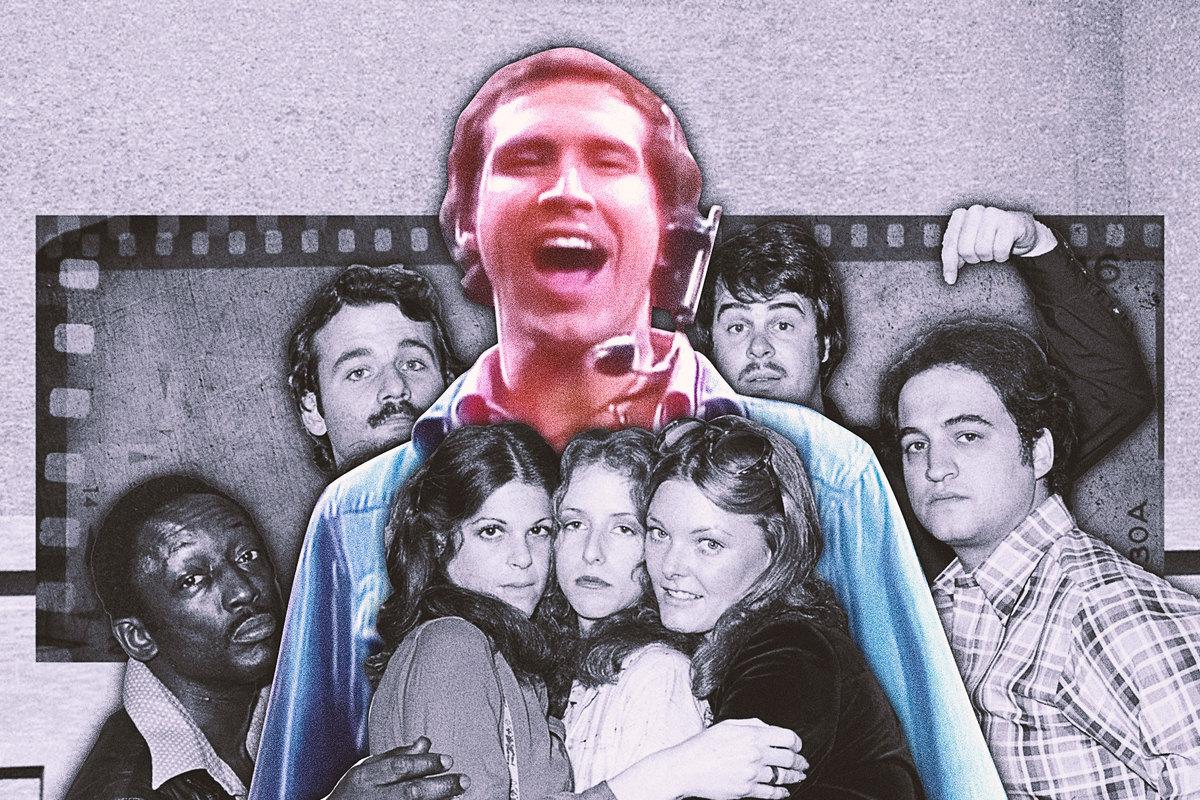A Timely Rewatch of the First Episode of ‘Saturday Night Live’
Jason Reitman’s new movie, ‘Saturday Night,’ dramatizes the lead-up to the series premiere of the groundbreaking sketch comedy show—but it also glorifies it. Watching the actual results of that lead-up tells a slightly different story.
Late in the very first episode of Saturday Night Live, the show cuts to pretaped footage of a big red flatbed truck slowly rolling through a suburb. A bunch of people on the back are holding up a sign that reads, “SHOW US YOUR GUNS.”
“We at Saturday Night wanted to see what kind of people carry guns,” a narrator explains, “so we took our camera crew into the streets to find out.”
Then, the William Tell overture kicks in as the camera starts passing by citizens whipping out their firearms. A guy working a grill points to his rifle, a woman excitedly runs out of her house with a submachine gun, a mom takes a revolver out of her kid’s stroller, two robbers knocking over a liquor store at gunpoint stop to wave, the liquor store owner in pursuit of the assailants does the same thing, a little old lady yanks a pistol out of her purse, and an entire wedding party wiggles their weapons. The only ones who don’t play along are two mobsters. Oh, and there’s a police officer who can’t, for the life of him, find his sidearm. The bit ends with one more line of voice-over: “If you see our Saturday Night truck in your neighborhood, show us your guns!”
This is the closest the series premiere comes to SNL at its best. There’s appropriately unsubtle social commentary about America’s obsession with guns that’s as relevant today as it was when it aired in October 1975, a swift escalation into absurdity, and enough visual gags to reward you for rewatching it repeatedly. The short is all the million-dollar adjectives that journalists like me have used to praise the early days of the show: subversive, transgressive, groundbreaking.
But it’s only one sketch—a 90-second chunk of an hour-and-a-half-long broadcast. Most of the rest of the episode, understandably, isn’t quite as fully formed—though you might not believe that if you’ve seen Saturday Night, the new movie about the chaotic lead-up to the debut. Named for the original title of NBC’s late-night series and depicting the 90 minutes before the very first episode, Jason Reitman’s dramatization tells the tale of Lorne Michaels and his motley crew on the precipice of changing the world. Not in the near future, but that evening. It relishes knowing exactly what Saturday Night Live became: a showcase for some of the funniest up-and-comers on earth, weekly appointment viewing, and the most influential comedy of the past 50 years. But that all-too-alluring desire to celebrate its legacy in a story contained to one night in 1975 undermines the show’s uncertain beginnings.
Back then, no one involved had a clue that they were about to start a revolution. “I don’t think it concerned us one way or the other,” Chevy Chase, a founding cast member, told Dave Itzkoff of The New York Times in September. “We were going to do what we do, and if you laugh, great, you laugh. You’ll tell somebody else about it, and they’ll laugh the next time.”
The actual series premiere is a much different story than the behind-the-scenes account of it. SNL wasn’t instantly a comedy juggernaut, but there were signs of how big it was going to get. Rewatching the first episode, you get a clear look into the origins of an American institution, which was, even at the outset, unpredictable. That’s the thing about live television: good or bad, you never know what will happen next.
The show kicks off, fittingly, with a shock. In the first cold open, a teacher (Michael O’Donoghue) gives English lessons to an immigrant (John Belushi). The soft-spoken student faithfully repeats the things the instructor says, starting with, “I would like … to feed your fingertips … to the wolverines.” The lesson then ends abruptly, as the professor has a heart attack and keels over before his pupil, mimicking to the death, does the same. The inaugural sketch ends with Chevy Chase in a headset breaking the fourth wall, walking onstage and announcing, “Live from New York, it’s Saturday Night!”
Revisiting “The Wolverines” recently reminded me of three things:
- How hilarious Belushi could be without, well, acting like a wolverine.
- How much of a natural Chase seemed to be in front of the cameras.
- How short the sketch is.
The scene was only a minute and a half long for a reason, and it definitely wasn’t because of some high-minded brevity-is-the-soul-of-wit philosophy. Michaels wanted to make his point fast, just in case the rest of the night was a disaster. “Whatever else happened, there would never have been anything like this on television,” he said in James Andrew Miller and Tom Shales’s definitive oral history of SNL, Live From New York. “No one would know what kind of show this is from seeing that.”
So what kind of show was it? Format-wise, the series premiere is a little bit different from what Saturday Night Live turned into. It feels more like a true variety show, moving quickly from the host, to live sketches, to pretaped bits, to musical performances by Billy Preston and Janis Ian, and back to the host. There is, notably, barely any time for viewers to linger on something that they don’t like.
The first SNL host—billed as the episode’s “star” back then—was comedian George Carlin. He was already 38 but still had enough counterculture cred to be considered an edgy headliner. That night, he wasn’t, well, quite as focused as he would’ve liked. “I certainly was full of cocaine,” he wrote in his memoir, Last Words. “(Though I was far from the only one).”
Carlin opens with one of his most well-known routines, about all the differences between two sports: football and baseball. By the end, it’s pretty clear which one he thinks is more American. “Football’s a ground acquisition game,” the comic says. “You knock the crap out of 11 guys and take their land away from them. Of course, we only do it 10 yards at a time. That’s the way we did it with the Indians. We won it little by little.”
Carlin chose to stick to stand-up that evening, leaving all the sketch work to the Not Ready for Prime Time Players. “I really wasn’t a born actor,” he once said in an interview with the Television Academy Foundation. “I think I never really felt comfortable in collaborative efforts. I never liked being part of the group.”
The crowd at Studio 8H laughed during his multiple monologues, but Michaels soon realized that for Saturday Night Live to reach its potential, the host needed to be integrated into the cast. It was obvious: seeing if an outsider could survive a live TV broadcast was exciting. Without that variable, the show wouldn’t have become what it became.
It’s hard not to grade the SNL series premiere on a curve. The main goal of the first episode of the series was to get through it. But even while the kinks were being worked out, and even with 30 Rockefeller Plaza allegedly being a cinematically tumultuous place that night, it was by no means a shit show. If you watch it now, there are windows, big and small, to the future.
The sketch after the show opens is the first SNL commercial parody, for New Dad insurance. Which is exactly what it sounds like: “Within seconds after old dad is out, we’ll have New Dad there to take his place.” Dan Aykroyd’s character comes home to his family, sits on the couch, gently croaks—his face gets X’ed out and he fades away—and Chevy Chase appears and takes over. It’s a fitting introduction to an on-screen persona the country would soon be seeing a lot of: tall, handsome, and smug.
Chevy’s presence made him a believable fake news anchor. As soon as he sat down behind the “Weekend Update” desk, the studio audience seemed to buy in. I definitely did, too, even if many of the jokes, including several about the president he’d soon play on the show, were sophomoric. This one sums up Chase’s trademark tone: “The Post Office announced today that it is going to institute a stamp commemorating prostitution in the United States. It’s a 10-cent stamp, but if you want to lick it, it’s a quarter.”
Throughout the premiere, you can sense cast members starting to settle into comfortable roles. At one point, Aykroyd bursts into a living room in a ski mask, grabs a terrified Belushi, and points a gun in Gilda Radner’s face. “Don’t call the police! I am the police,” he says, trying to assure them. “I might be, anyway.” Turns out he’s not a burglar but the president of Trojan Horse Home Security—and this, he claims to the couple he’s just scared shitless, is a simulation. And thus began Aykroyd’s career as a deranged pitchman, a part he played to perfection for the next half decade.
Belushi’s work on SNL is a big reason he’s considered one of the greatest physical comedians of all time. But in the first episode, we don’t actually get to see him going wild. The world would have to wait for his Joe Cocker impression and his Greek diner owner. There is one moment, though, beyond the cold open, that does hint at the kind of comedy we’d get from him in the near future. In a very brief sketch, he’s the guest on a talk show, hosted by Jane Curtin, called Victims of Shark Bite. (This is four months after Jaws came out and a month before the first “Land Shark” bit.) Belushi is the victim, but we quickly learn that a shark didn’t really bite his left arm off. Watching him desperately try to convince his interviewer that he’s not a fraud while not losing his cool—as he’s accidentally revealing his non-severed arm—is hilarious.
As a necessity, Reitman’s Saturday Night touches on how a significant number of cast members had to fight for airtime. Knowing that the three women and one Black man in the original troupe felt marginalized back then, it’s hard not to notice that the spotlight is rarely turned on them. (Ironically, their stories are also marginalized in the movie.) Though in the first episode, they made the most of their airtime. Garrett Morris appears as an attorney in a forgettable courtroom sketch and as Aykroyd’s masked partner in the home security ad. During “Weekend Update,” Chase cuts live to Laraine Newman, who’s playing a reporter at a motel where 38 people have been killed. “The motive, again, murder,” she says, “as it has been in the previous 37 slashings.” Curtin shines as a straight woman opposite Belushi and on the witness stand in the aforementioned courtroom sketch. It’s very obvious, even in the first episode, that her deadpan delivery would make her a natural successor to Chase on “Weekend Update.” Radner, meanwhile, doesn’t get to ratchet up her energy level, except while playing a woman in an ad for a training school for late-night infomercial stand-by phone operators. (Good luck explaining that bit to anyone under 35.)
SNL, at least on its first night, is at its funniest when it leans into American absurdity. “SHOW US YOUR GUNS,” Andy Kaufman lip-syncing the chorus to “Mighty Mouse.” Albert Brooks’s fake newsmagazine The Impossible Truth, which covered topics like the life of a blind New York City cabbie and a man who can eat 1,000 eggs. The cast as expectant fathers in black-and-yellow insect suits starring in a mock soap opera called Bee Hospital. And a prescient commercial parody for a new and improved razor with THREE blades. “The Triple-Trac,” the narrator says confidently. “Because you’ll believe anything.”
Of course, not everything was a hit. Jim Henson’s contribution to SNL, for example, “The Land of Gorch,” drags. The episodic Muppets sketch, a dark satire that took place on a swamp planet, just doesn’t seem to fit on a fast-moving, topical sketch series. (Maybe this is why Saturday Night viciously dunks on Henson, an undeniable creative genius turned unfortunate square peg, nearly every opportunity it gets.)
But if you’ve watched the show over the past 50 years, this shouldn’t surprise you. I’m not sure there’s ever been a perfect week of SNL. There are always at least a few duds. So opening night, inadvertently, was a prototypical Saturday Night Live episode: There are a handful of transcendent sketches mixed in with ones that don’t work as well.
George Carlin ends the first show by plugging his new stand-up album and saying goodbye to the audience. SNL had made it through its opener without any true disasters. For the cast and crew, it was an impressive achievement. But revolutions aren’t made in one night. The hard part came the next week, when the cast and crew had to do it all over again.

